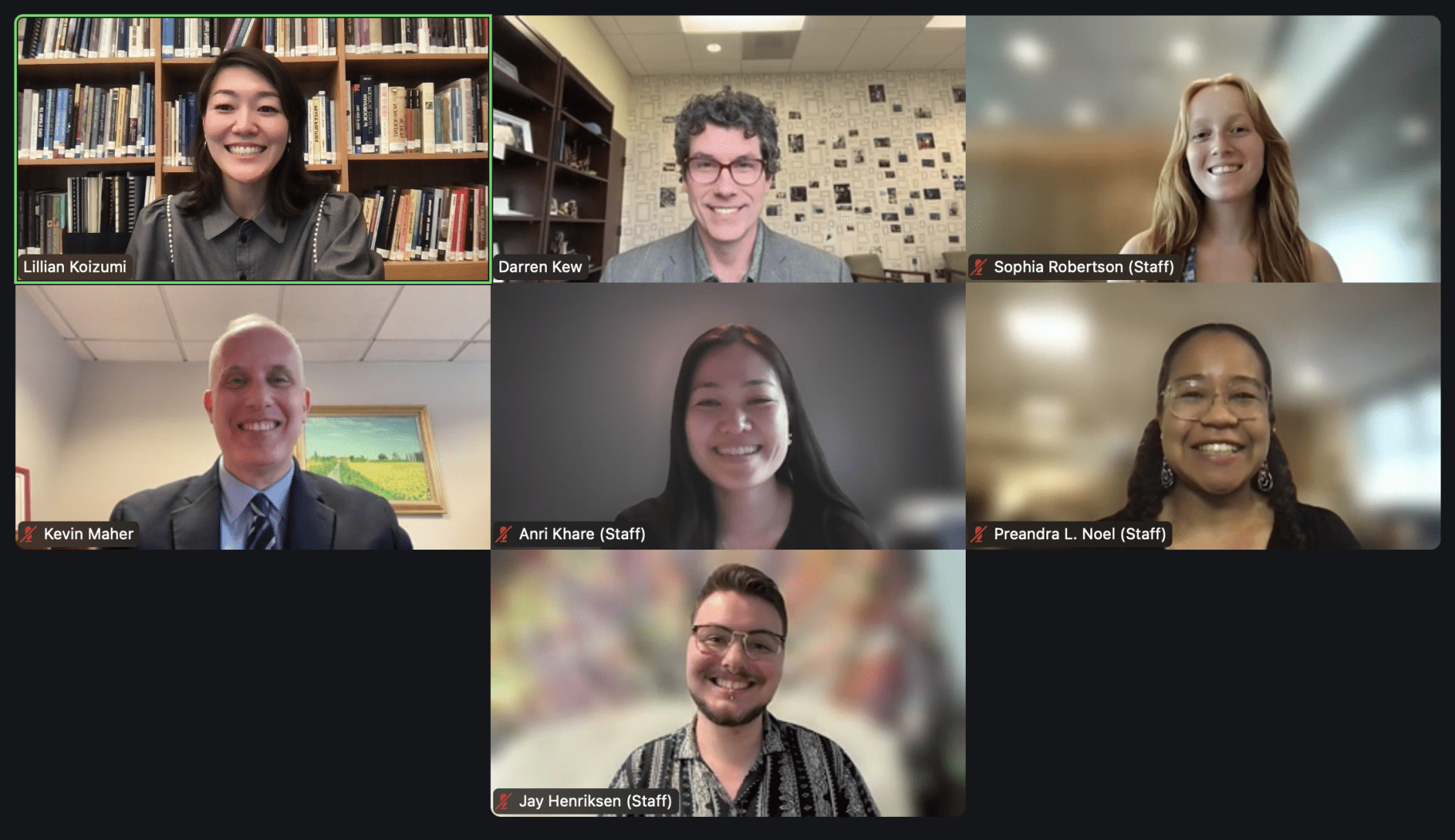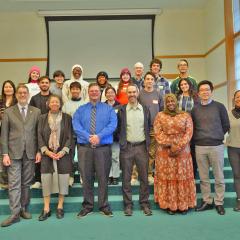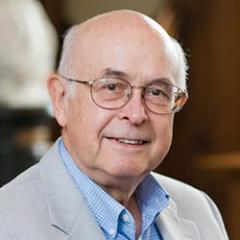2025 Indigo Talk: Darren Kew On Ways Religion Enhances Peacebuilding Efforts
“Good evening, good morning, good afternoon to all of our friends joining us today!” With these words of greeting, Lillian Koizumi opened the Ikeda Center’s annual Indigo Talk, which, as the Center’s only virtual event, is attended by individuals representing many different time zones in the world. This year’s talk featured remarks from Darren Kew, Dean of the Joan B. Kroc School of Peace Studies at the University of San Diego. Among the instructive findings that Dr. Kew shared during his talk, called “Reflections on Religion and Peacebuilding,” drawn from his many decades’ experience with conflict resolution, was that religions offer unique ways to help even the most intransigent conflict situations get unstuck.
Before turning the screen over to Dr. Kew, Koizumi shared some background on Center founder Daisaku Ikeda, the lecture series, and Dr. Kew’s extensive experience. All of Mr. Ikeda’s work for peace, which he pursued with vigor up until his death at age 95 in 2023, stemmed from his firsthand experience of the “sufferings and tragedies of war,” including the death of his elder brother, Kiichi, whom he revered. “Based on those experiences and his practice of Nichiren Buddhism,” said Koizumi, “he dedicated his entire life to fostering a culture of peace through dialogue.” The Ikeda Center is one of the institutions he founded to advance that mission. Now in its fifth year, the Indigo Talks series derives its name and purpose from the Chinese allegory of the indigo plant, which suggests that just as items repeatedly dyed with indigo turn bluer than the indigo itself, individuals engaged in devoted learning experience the steady deepening of their wisdom, courage, and compassion.
Koizumi then introduced Dr. Kew, who studies the relationship between conflict resolution methods – particularly interfaith and inter-ethnic peacebuilding – and democratic development in Africa, Northern Ireland, and the United States. His collaborations with the Ikeda Center go back many years to when he was at the University of Massachusetts, Boston, where he served as the Chair of the Department of Conflict Resolution, Human Security, and Global Governance, and Executive Director of the Center for Peace, Democracy, and Development. As shared during his talk, much of the knowledge and wisdom he has gained derives from his work of many years participating in and facilitating interfaith and inter-ethnic peacebuilding processes in Nigeria.
Reflections on Religion, Mediation, and Peacebuilding
Dr. Kew opened his remarks with words of thanks to the Ikeda Center for providing this “incredible opportunity” to talk with people from around the world about what he has learned as a peacebuilding practitioner and researcher. So often, he said, “when we think about religion, the next word that comes in the sentence is often conflict or warfare or something like that – particularly in our studies in conflict resolution and peacebuilding.” One important reason that religion does so often play a role in conflict, noted Kew, is that religiously-oriented differences fall in the category of value-based conflict. When values are involved, it is inherently more difficult to compromise than if you were, say, settling a price difference dispute between 50 and 100 dollars, where a compromise of 75 is readily available. Yet it is also true, he observed, that religious practitioners are frequently the leaders in conflict resolution efforts worldwide.
For tonight’s talk, Dr. Kew said he would be sharing what he has learned though his long-term collaborations in Nigeria with two such peacebuilders in particular: Pastor James Wouye and Imam Muhammad Ashafa. These men, a Christian and a Muslim, respectively, both went through processes of transformation in which, incredibly, each went from being the sworn enemy of the other – even going so far as being involved in attempts on the other’s life – to becoming close friends and collaborators seeking to mend Christian-Muslim hostilities in Nigeria. Together, they formed an NGO, the Interfaith Mediation Center, in Kaduna, and this is where Kew has consulted and participated in conflict resolution work with them for nearly 20 years now. For context, he explained that the Nigerian population is divided nearly evenly between Christians and Muslims, though there are many variations within each, as well as many communities of traditional or indigenous belief systems. Like value conflicts, 50-50 conflicts also carry particular challenges, said Kew. In this case, the conflict is seen as a “zero sum game” and “one side’s gain is seen as the other side’s loss,” a situation that “makes compromise extremely difficult.” Nevertheless, Pastor James and Imam Ashafa have been quite successful, said Kew, not least because of the unique tools that religious leaders have that can enhance resolution processes among believers. Pastor James and Imam Ashafa are also successful because of the power of their stories, which tell of their journeys from hatred and violence to forgiveness. These themes provided the basis for the rest of Kew’s remarks.
First, Kew shared with attendees the general contours of the religion-grounded approach to conflict resolution employed at the Interfaith Mediation Center. In all, there are five steps, beginning with a focus on the inner preparation and transformation of participants. Secular peacebuilders do address this need, too, but Kew has found that religious adherents often “put a real premium” on this step, since “religions by definition have entire systems about inner preparation and transformation.” Be it through prayer or meditation, religious people often engage in rituals that take them back to “the central spiritual source” of their faith. The second is more procedural, as Pastor James and Imam Ashafa will “set up the peace team that will do the intervention.” These will include participants from all sides or groups involved in a conflict. Next is the preparation phase for larger outreach and then comes the meetings and workshops themselves. Finally, a follow-up effort to try to change the systems of the conflict based on the findings and outcomes of the workshop – “an effort to sort of scale up the impact,” said Kew.
Turning to an in-depth discussion of the workshops themselves, Kew said that storytelling is heart of things. While this is true of all mediations, including secular ones, it can be especially important in religious settings, since they have a language of redemption and reconciliation. Pastor James tells of a singular experience he had on his journey. At one point, he was attending church and the minister “was talking about the importance of forgiveness, and how Jesus put such a premium on turning the other cheek and forgiving one’s enemies, and how one cannot be a good Christian with hatred in your heart.” Pastor James felt like he was “being singled out,” said Kew, and he felt like hiding. But more and more he “felt like the spotlight of God was on him,” and knew he could not continue as he had. The Imam tells of how, the more time he spent in prayer and meditation and in studying the Quran, the more he felt that if he were to be honest with himself then he could not continue with “the violence he had espoused.” It was these experiences that led these two men to their reconciliation and their desire to model for others how transformative experience can lead to peace.
Kew then described the core dimensions of their peacebuilding approach, some of which aren’t always transferable to secular settings. For example, the Pastor and Imam freely admit they engage in what they call “divine intimidation.” They invoke Jesus and the Prophet, respectively, and frankly state that individuals are not living up to what their faith expects of them as long as they persist on the path of conflict. A closely related phenomenon relates to the status the clergy enjoy in Nigeria, as well as in other highly religious societies. The Pastor and the Imam will use their positions of authority to urge people along the path to reconciliation. A third factor unique to religious settings is that participants will engage in reading one another’s sacred texts, which is important, said Kew, as it “helps to challenge preconceptions and stereotypes that they have of each other.” Equally crucial, though, is that participants will see Christians disagreeing among themselves and Muslims disagreeing among themselves. “And why that is so important from a peacebuilding perspective,” said Kew, is that:
when people have absolute certainty about convictions, absolute certainty about the history that has happened between them, it leaves very little room for negotiation. And the more that you can muddy these waters a little bit, the more you can see that even the sacred has differences, and it’s not as black and white, zero sum, as we thought it was; the more you can muddy these waters, the more you can get people to have a sense of alternative movement to work out a system of understanding and a solution to our problems that we can move forward with.
The next key dimension is that of forgiveness. Again, secular mediators may have a more difficult time than do religious practitioners in expecting apologies from participants in a conflict. And while religious mediators know that a “forced” apology is not helpful, they can also argue, for example, that we are all part of God’s creation, and all is sacred, so reconciliation is the only true way to respect that truth. Finally, religious-based reconciliation processes are strengthened by the ability to follow-up on the peace process regularly, for example during weekly services, which provides an advantage over secular processes, which often find follow-up difficult to coordinate.
Ultimately, said Kew, because of the way that religions are able to facilitate processes of inner change, both through certain practices and through the tenets and narratives of their respective faiths, there is a “leapfrog” affect that can help religiously-oriented mediations get to reconciliation quicker than more secular mediations can. What we are talking about, clarified Kew, is enough individuals having transformative experiences that enable them to override the sorts of constraints that hold back the breakthrough agreements and compromises necessary to peacebuilding. One example, said Kew, is the way that religious transformations can enable individuals to override the usual “cost-benefit analysis” that can lead people to not do things they feel in their hearts to be right. Citing the experience of Protestants and Catholics in Northern Ireland during “the Troubles,” Kew observed that while people in these groups might want to relate to each as friends when they are at the pub, the tribal nature of the conflict meant one could be severely ostracized for doing so. Yet, if someone has had an experience that elevates their perspective, they may feel that the risk is worth it to pursue the higher goal of the unity of humankind.
To wrap up, Kew mentioned a few questions and concerns to bear in mind when considering what can be learned from religious mediation and reconciliation. First, are these practices actually transferable to less—religious communities? Next, is it okay that participants seem to be skipping over what might be considered the necessary processing time needed to reconcile? Might grievances soon resurface? Third, is what Kew called the “synthesis dilemma.” When religious practitioners seek common ground, are they harmfully watering down their own faith? A fourth concern is whether traditional religious communities are overly patriarchal and downplay the leadership of women. Finally, said Kew, there is the need for much more comparative data attempting to clarify these sorts of questions and concerns.
Q & A: The Path of Sustainable Peacebuilding
Thanking Dr. Kew for his thoughtful remarks, Koizumi said that Pastor James and Imam Ashafa serve as “role models of what peacebuilding can look like in these times, when feelings of mistrust and hatred are so strong and deep. I think these narratives and examples of forgiveness and transformation are so encouraging and powerful, and are narratives that we don’t hear enough these days.” She then invited participants to pose questions for Kew, with time enough for three or so. The first question asked what we can do, during this time when peace seems so fragile and under threat, to create lasting, sustainable peace, even when regions undergo societal changes? Kew said that we are indeed “at the sort of The Empire Strikes Back part of the trilogy where our heroes are on the back foot, but I do feel like the winds are changing, and that things will be heading back in the right direction.” To bring things down to basics, Kew said that each of us needs to attend to our own internal journeys. As he tells his students, “you cannot be a good mediator or facilitator or peace builder” until you “try to deal with your own internal wounds, demons, conflict issues, and the relationships in your own life.” Which doesn’t mean mediators need to be perfect, but paying attention to your own pain can increase empathy for others. In a larger sense, what successful peacebuilding needs is for this individual level to be joined by the state and global levels. The level of individual and small group action is so important because when “politicians and global actors are ready to talk,” the ground-level energy is there to push them forward, observed Kew.
The second question asked about the role of fear and how people’s experience of trauma impact peacebuilding efforts. Well, said Kew, in essence, “fear is the enemy of the good” in peacebuilding. However, once in a room together, trust and connection can be built. It’s the getting sides together that can be the hardest part, he added. Kew then noted a few ways to overcome or transcend fear. In mediation sessions, the mediator or facilitator can work effectively as a bridge if they are trusted by both sides. Some religious facilitators lead prayer or meditation sessions to instill a healthy, productive perspective. The arts also have the ability to open people up. And, above all, storytelling can be transformative as it invites human feeling and empathy among all participants, transcending fear in that manner. As a quick follow up, Koizumi asked Kew to talk about his own spiritual practice and journey. All of us, he said, are on that “hero’s journey” that Joseph Campbell spoke of, trying to “constantly self-improve and evolve as human beings.” For him, it means practices such as meditation, but also awareness of how the pain he has experienced can help him be more sensitive to the pain of others, while acknowledging the limits of what he can truly understand about others’ experiences. Most of all he seeks to approach others with “humility and respect.”
Finally, an education school graduate student asked how religion-based or -related peacebuilding practices can be employed in classrooms. The “starting place,” said Kew, is always to know what the “parameters” regarding religious or spiritual content are in the school where you teach. Frequently, topics that have religious overtones are best addressed in the context of values or ethics education. Also, reflective activities can be conducted without there needing to be specific religious or spiritual connotations. When it comes to peace education, sometimes people have an easier time accepting the framing of coexistence. Above all, talk with everyone from principles, administrators, parents, and at higher grade levels students themselves about what you are doing and hoping to achieve. “Convert them to [being] champions,” said Kew, “and then they will help open those doors.”
Kevin Maher: Concluding Thoughts
“As we draw this inspiring evening to a close,” said Kevin Maher, “I want to extend deep appreciation to Dr. Darren Kew for his insightful, timely, and hope-filled talk on religion and peacebuilding.” Noting that so much violence and conflict in the world is associated with or justified by violence, Maher said that “as Dr. Kew has reminded us, religion can be a wellspring of healing, forgiveness, and resilience. Beginning with inner preparation and transformation, religion can inspire individuals and communities to build bridges where walls have long divided.” Listening to Kew’s talk, Maher said he detected strong resonances with Daisaku Ikeda’s “concept of human revolution—the inner transformation of an individual as a catalyst for broader societal change.”
The spirit of Ikeda’s expansive vision was present in a speech Mr. Ikeda delivered at the University of Havana in 1996, titled “Building a Great Spiritual Bridge to the New Century.” In a quote shared by Maher, Ikeda emphasized that:
The transformation in the inner awareness or state of life of an individual is intrinsically connected to the flowering of the poetic spirit. An expansion in this inner realm of life encourages empathy for others and strengthens the desire to contribute to society; it brings forth the ‘sun’ of wisdom and compassion from within the depths of one’s life. The light of this ‘sun’ is that of respect for human dignity and for the sanctity of all life, and it can be tapped equally by all. The process of human revolution, bringing forth this inner sun, is the motive force that can enhance solidarity among people, lead to the prosperity of society, and create peace for humankind.
Of the many hundreds of participants from dozens of countries who have joined the virtual Indigo talks since its inception in 2021, Maher observed that all are “united by a shared commitment to exploring pathways to peace.” Then, addressing the assembled attendees, Maher concluded that “your presence tonight is a powerful reminder of the enduring hope we hold: that through deep listening, meaningful dialogue, and shared reflection, we can work together to shape a more peaceful world.”


